#Realtime data
Explore tagged Tumblr posts
Text
Analytics and BI
Traqops helps businesses improve their overall productivity and performance by automating various tasks and processes. In turn, this can lead to increased profits and competitive advantage. Integrated analytics for connected & smart facilities. Insightful data leads to intelligent decisions.
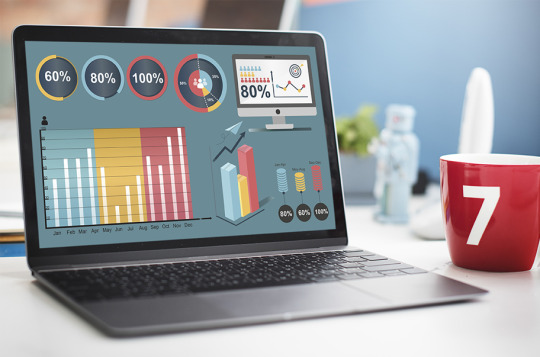
1 note
·
View note
Text

Data Corruption.
#gif#art#artists on tumblr#design#pi-slices#animation#loop#trippy#abstract#touchdesigner#realtime#generative#data corruption#surreal#aesthetic#glitch
804 notes
·
View notes
Text

💁♀️ TrueData Super Simple Market Data APIs
📶 Power your Algo Trades with our Low latency WebSocket APIs.
Read More: https://www.truedata.in/products/marketdataapi
0 notes
Text
I think I understand enough about blender to make cutout puppet rigs that I could puppeteer in realtime
Like some weird marriage of shadow puppets and flash animation
#if i cant figure out how to manipulate the rig in realtime and layer performances that way#i know i can just puppeteer the movement with some tracking markers on a popsicle stick and just parent the rig to the track data#might not work for every shot i think id rather just do drawings#but there's probably shots that could be executed like that where you could get some nuanced performance out of what would have been a hold
0 notes
Text
Photon Insights: How AI is Redefining Data Visualization in Research
In a time when data is being generated at a rapid pace and the ability to visualize intricate information is essential for research across a variety of fields. Data visualization helps researchers analyze and present findings with greater ease by making complex data easy to comprehend and accessible. Photon Insights is leading the revolution in the field of visualization of data using the latest AI technologies that provide researchers with cutting-edge tools to improve their ability to analyse the data and communicate it. This article explains the ways in which AI transforms data visualization and the central part Photon Insights plays in this development.
The Importance of Data Visualization in Research
Data visualization is essential for a variety of reasons:
1. “Simplifying complex data Researchers are often faced with huge quantities of data. Effective visualization converts complex data into clear, concise representations, allowing users to gain insight quickly.
2. Identifying Trends and Patterns Visualizations are able to reveal trends as well as outliers, correlations and trends which are not apparent in the raw data. This is crucial for drawing meaningful conclusions as well as aiding in decision-making.
3. Improved Communication: Effectively designed visualizations present the findings to a larger public, even those with an academic background. This is crucial for involving the policymakers, stakeholders, and the general public.
4. Facilitating Collaboration Data visualizations are an unifying language for researchers from various fields, encouraging inter-disciplinary collaboration and dialog.
The Role of AI in Enhancing Data Visualization
Artificial Intelligence is revolutionizing data visualization through tools that automate, improve and create new ways in which data is displayed and interpreted. There are many ways AI can make a huge impact on data visualization:
1. Automated Data Processing
AI algorithms can cleanse and clean data, thereby cutting down on the time spent by researchers creating datasets for visualisation. This process ensures that data is reliable, accurate and is ready to be analyzed.
2. Intelligent Data Interpretation
AI-powered tools are able to analyze data and recommend the most effective visualization techniques based on fundamental characteristics of the data. This sophisticated interpretation aids researchers to choose the best charts or graphs to communicate their findings.
3. Enhanced Interactivity
AI allows the creation of interactive visualizations that permit users to look at data in a dynamic way. Researchers can design dashboards so that people can control variables and see various scenarios, increasing the level of engagement and understanding.
4. Predictive Visualization
With the help of analytic predictive capabilities, AI will be able to forecast the future developments and show potential outcomes based on data from the past. This ability allows researchers to make predictions based on data and plan in accordance with them.
5. Real-Time Data Visualization
AI provides real-time data visualization that allows researchers to make updates to their visualizations when new data is made available. This is essential in areas like finance, healthcare and social sciences, where quick insights can dramatically affect the results.
Photon Insights: Leading the Transformation
Photon Insights stands out as an innovator in the field of visualization of data through AI. The platform comes with a set of tools that are designed to improve researchers’ abilities to analyze visualize, communicate, and share their findings efficiently.
1. Comprehensive Data Integration
Photon Insights combines data from various sources which allows researchers to construct comprehensive visualizations that incorporate diverse data sets. This method of analysis is comprehensive, allowing users to study patterns and connections across different data points.
2. User-Friendly Interface
The platform comes with a user-friendly interface that makes it easy to navigate through the process of creating visuals. Researchers can drag and drop components, modify designs, and create visual outputs without requiring vast technical expertise.
3. Advanced AI Algorithms
Photon Insights employs cutting-edge AI algorithms to automate data processing and visual suggestions. This means that researchers will have less time to manage logistics, and spend more time analyzing and interpreting.
4. Interactive Dashboards
By using Photon Insights, researchers can develop interactive dashboards that permit users to interact with data actively. Interactivity encourages collaboration and increases stakeholder understanding and makes research findings more effective.
5. Customizable Reporting Tools
Photon Insights provides customizable reporting tools that allow researchers to modify their visuals to meet the needs of specific groups. This flexibility is crucial for effectively presenting complex findings to diverse people.
Case Studies: The Impact of AI-Driven Visualization
To show the potential transformative of AI in visualization of data, take a look at the following case studies that show how Photon Insights has had an important impact:
Case Study 1: Healthcare Research
In research in healthcare, visualizing patient data can help reveal important patterns in outbreaks of disease and treatment efficacy. Utilizing Photon Insights’s technology researchers were able to automate the review of patient data and create real-time dashboards which display the demographics of patients, their outcomes of treatment, and the prevalence of disease. The dashboards allowed healthcare providers to make fast, informed decisions which ultimately improved the quality of care for patients.
Case Study 2: Market Research
A marketing team that is analyzing the behavior of consumers, Photon Insights allowed for the integration of data from surveys and social media analytics, as well as sales data. The AI-driven platform suggested the best ways to display data, which resulted in interactive charts that revealed trends and preferences of consumers. This improved the ability of the team to plan and execute their marketing campaigns efficiently.
Case Study 3: Environmental Studies
In the field of environmental research, recognizing the complexity of data sets that are related to climate change is essential. Researchers employed Photon Insights to display large amounts of data on temperature fluctuations as well as carbon emissions and environmental impacts. The ability to predict visualizations enabled them to present possible future scenarios that could inform policymakers and encouraging the public to take climate change action.
“The Future of Data Visualization with AI
In the years ahead, as AI technologies continue to advance its influence on visualization of data will only grow. Certain trends will influence what the next phase of AI will look like:
1. Enhanced Personalization.
AI can provide more personalised visualizations that are tailored to particular audience requirements, increasing the user’s engagement and understanding.
2. Greater Accessibility: The latest developments in AI can allow data visualization tools to be accessible to those who don’t have expertise, while also making data interpretation more accessible across different disciplines.
3. Integration with Virtually as well as Augmented Reality: The application for VR as well as AR in visualization of data will provide the user with immersive experiences, and allow them engage with their data in different and creative ways.
4. Enhanced Collaboration.
AI will enable more robust collaboration among researchers from different disciplines, leading to deeper analysis and deeper insights.
Conclusion
AI is changing the face of research data visualization by enabling researchers to transform their data into compelling, clear visuals that aid in understanding and facilitate communication. Photon Insights is at the forefront of this change by providing tools that automate data processing, suggest efficient visualization methods and facilitate collaboration between researchers.
Through the use of AI technology, Photon Insights empowers researchers to present their research findings in an appealing and effective method. As the need for efficient visualization of data continues to increase platforms such as Photon Insights will play a significant part for shaping research’s future. They will make the findings more easily accessible and actionable to all those that are. The new era of visualization of data is underway and AI is driving the way.
0 notes
Text
Wither
Artist: Thijs Biersteker
Biersteker, T. (2022) Wither [Sculpture]. Available at: https://thijsbiersteker.com/wither-2021 (Accessed: 8 October 2024).
"In his practice, he collaborates with the world’s top scientists and institutions to turn their climate data into art installations that make the overwhelming challenges ahead accessible, understandable and relatable." (https://thijsbiersteker.com/about-1)
youtube
"Controlled by the latest deforestation data, the leaves of this digital slice of rainforest turn transparent before your eyes. Every second, ten leaves disappear, with each flicker signifying the loss of 1280 square meters of rainforest." (https://thijsbiersteker.com/wither-2021)
Climate: The work is based on scientific data to bring to life data related to deforestation. Interested in producing something that gets us closer to how climate change feels.
Time: Engages with the temporal dimension of the changes happening in rain forests to express the speed of change. Helping the audience to see the data.
#realtime#installation-art#trees#artistic-activism#artwork#climate-change#attunement#relation-time#extinction#forest#data-visualisation
0 notes
Text
0 notes
Text
Attention Business Leaders! 📈 In today's fast-paced market, data analytics is the key to unlocking unparalleled customer experiences. By harnessing the power of data, businesses can tailor services like never before, ensuring satisfaction at every touchpoint. Dive into our latest insights on how this strategy is revolutionizing customer engagement.
#customer experience#data#data analytics#data driven#customer insights#personalization#omnichannel#big data#realtime#getondata
1 note
·
View note
Text
crystal drawings


#nft#behance#digitalart#digital#digital art#generative#realtime render#touchdesigner#houdini#data painting
1 note
·
View note
Text
The cod-Marxism of personalized pricing
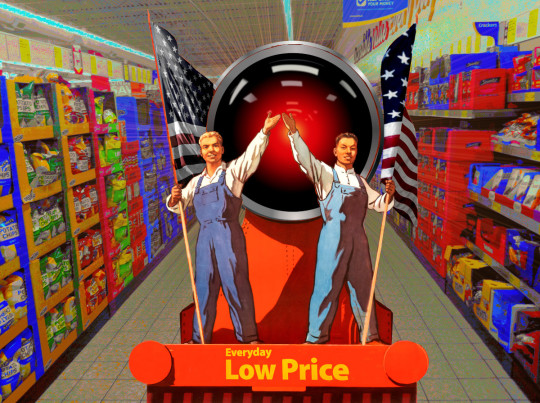
Picks and Shovels is a new, standalone technothriller starring Marty Hench, my two-fisted, hard-fighting, tech-scam-busting forensic accountant. You can pre-order it on my latest Kickstarter, which features a brilliant audiobook read by Wil Wheaton.

The social function of the economics profession is to explain, over and over again, that your boss is actually right and that you don't really want the things you want, and you're secretly happy to be abused by the system. If that wasn't true, why would your "choose" commercial surveillance, abusive workplaces and other depredations?
In other words, economics is the "look what you made me do" stick that capitalism uses to beat us with. We wouldn't spy on you, rip you off or steal your wages if you didn't choose to use the internet, shop with monopolists, or work for a shitty giant company. The technical name for this ideology is "public choice theory":
https://pluralistic.net/2022/06/05/regulatory-capture/
Of all the terrible things that economists say we all secretly love, one of the worst is "price discrimination." This is the idea that different customers get charged different amounts based on the merchant's estimation of their ability to pay. Economists insist that this is "efficient" and makes us all better off. After all, the marginal cost of filling the last empty seat on the plane is negligible, so why not sell that seat for peanuts to a flier who doesn't mind the uncertainty of knowing whether they'll get a seat at all? That way, the airline gets extra profits, and they split those profits with their customers by lowering prices for everyone. What's not to like?
Plenty, as it turns out. With only four giant airlines who've carved up the country so they rarely compete on most routes, why would an airline use their extra profits to lower prices, rather than, say, increasing their dividends and executive bonuses?
For decades, the airline industry was the standard-bearer for price discrimination. It was basically impossible to know how much a plane ticket would cost before booking it. But even so, airlines were stuck with comparatively crude heuristics to adjust their prices, like raising the price of a ticket that didn't include a Saturday stay, on the assumption that this was a business flyer whose employer was footing the bill:
https://pluralistic.net/2024/06/07/drip-drip-drip/#drip-off
With digitization and mass commercial surveillance, we've gone from pricing based on context (e.g. are you buying your ticket well in advance, or at the last minute?) to pricing based on spying. Digital back-ends allow vendors to ingest massive troves of commercial surveillance data from the unregulated data-broker industry to calculate how desperate you are, and how much money you have. Then, digital front-ends – like websites and apps – allow vendors to adjust prices in realtime based on that data, repricing goods for every buyer.
As digital front-ends move into the real world (say, with digital e-ink shelf-tags in grocery stores), vendors can use surveillance data to reprice goods for ever-larger groups of customers and types of merchandise. Grocers with e-ink shelf tags reprice their goods thousands of times, every day:
https://pluralistic.net/2024/03/26/glitchbread/#electronic-shelf-tags
Here's where an economist will tell you that actually, your boss is right. Many groceries are perishable, after all, and e-ink shelf tags allow grocers to reprice their goods every minute or two, so yesterday's lettuce can be discounted every fifteen minutes through the day. Some customers will happily accept a lettuce that's a little gross and liztruss if it means a discount. Those customers get a discount, the lettuce isn't thrown out at the end of the day, and everyone wins, right?
Well, sure, if. If the grocer isn't part of a heavily consolidated industry where competition is a distant memory and where grocers routinely collude to fix prices. If the grocer doesn't have to worry about competitors, why would they use e-ink tags to lower prices, rather than to gouge on prices when demand surges, or based on time of day (e.g. making frozen pizzas 10% more expensive from 6-8PM)?
And unfortunately, groceries are one of the most consolidated sectors in the modern world. What's more, grocers keep getting busted for colluding to fix prices and rip off shoppers:
https://www.cbc.ca/news/business/loblaw-bread-price-settlement-1.7274820
Surveillance pricing is especially pernicious when it comes to apps, which allow vendors to reprice goods based not just on commercially available data, but also on data collected by your pocket distraction rectangle, which you carry everywhere, do everything with, and make privy to all your secrets. Worse, since apps are a closed platform, app makers can invoke IP law to criminalize anyone who reverse-engineers them to figure out how they're ripping you off. Removing the encryption from an app is a potential felony punishable by a five-year prison sentence and a $500k fine (an app is just a web-page skinned in enough IP to make it a crime to install a privacy blocker on it):
https://pluralistic.net/2024/08/15/private-law/#thirty-percent-vig
Large vendors love to sell you shit via their apps. With an app, a merchant can undetectably change its prices every few seconds, based on its estimation of your desperation. Uber pioneered this when they tweaked the app to raise the price of a taxi journey for customers whose batteries were almost dead. Today, everyone's getting in on the act. McDonald's has invested in a company called Plexure that pitches merchants on the use case of raising the cost of your normal breakfast burrito by a dollar on the day you get paid:
https://pluralistic.net/2024/06/05/your-price-named/#privacy-first-again
Surveillance pricing isn't just a matter of ripping off customers, it's also a way to rip off workers. Gig work platforms use surveillance pricing to titrate their wage offers based on data they buy from data brokers and scoop up with their apps. Veena Dubal calls this "algorithmic wage discrimination":
https://pluralistic.net/2023/04/12/algorithmic-wage-discrimination/#fishers-of-men
Take nurses: increasingly, American hospitals are firing their waged nurses and replacing them with gig nurses who are booked in via an app. There's plenty of ways that these apps abuse nurses, but the most ghastly is in how they price nurses' wages. These apps buy nurses' financial data from data-brokers so they can offer lower wages to nurses with lots of credit card debt, on the grounds that crushing debt makes nurses desperate enough to accept a lower wage:
https://pluralistic.net/2024/12/18/loose-flapping-ends/#luigi-has-a-point
This week, the excellent Lately podcast has an episode on price discrimination, in which cohost Vass Bednar valiantly tries to give economists their due by presenting the strongest possible case for charging different prices to different customers:
https://www.theglobeandmail.com/podcasts/lately/article-the-end-of-the-fixed-price/
Bednar really tries, but – as she later agrees – this just isn't a very good argument. In fact, the only way charging different prices to different customers – or offering different wages to different workers – makes sense is if you're living in a socialist utopia.
After all, a core tenet of Marxism is "from each according to his ability, to each according to his needs." In a just society, people who need more get more, and people who have less, pay less:
https://en.wikipedia.org/wiki/From_each_according_to_his_ability,_to_each_according_to_his_needs
Price discrimination, then, is a Bizarro-world flavor of cod-Marxism. Rather than having a democratically accountable state that sets wages and prices based on need and ability, price discrimination gives this authority to large firms with pricing power, no regulatory constraints, and unlimited access to surveillance data. You couldn't ask for a neater example of the maxim that "What matters isn't what technology does. What matters is who it does it for; and who it does it to."
Neoclassical economists say that all of this can be taken care of by the self-correcting nature of markets. Just give consumers and workers "perfect information" about all the offers being made for their labor or their business, and things will sort themselves out. In the idealized models of perfectly spherical cows of uniform density moving about on a frictionless surface, this does work out very well:
https://pluralistic.net/2023/04/03/all-models-are-wrong/#some-are-useful
But while large companies can buy the most intimate information imaginable about your life and finances, IP law lets them capture the state and use it to shut down any attempts you make to discover how they operate. When an app called Para offered Doordash workers the ability to preview the total wage offered for a job before they accepted it, Doordash threatened them with eye-watering legal penalties, then threw dozens of full-time engineers at them, changing the app several times per day to shut out Para:
https://pluralistic.net/2021/08/07/hr-4193/#boss-app
And when an Austrian hacker called Mario Zechner built a tool to scrape online grocery store prices – discovering clear evidence of price-fixing conspiracies in the process – he was attacked by the grocery cartel for violating their "IP rights":
https://pluralistic.net/2023/09/17/how-to-think-about-scraping/
This is Wilhoit's Law in action:
Conservatism consists of exactly one proposition, to wit: There must be in-groups whom the law protects but does not bind, alongside out-groups whom the law binds but does not protect.
https://en.wikipedia.org/wiki/Francis_M._Wilhoit#Wilhoit's_law
Of course, there wouldn't be any surveillance pricing without surveillance. When it comes to consumer privacy, America is a no-man's land. The last time Congress passed a new consumer privacy law was in 1988, when they enacted the Video Privacy Protection Act, which bans video-store clerks from revealing which VHS cassettes you take home. Congress has not addressed a single consumer privacy threat since Die Hard was still playing in theaters.
Corporate bullies adore a regulatory vacuum. The sleazy data-broker industry that has festered and thrived in the absence of a modern federal consumer privacy law is absolutely shameless. For example, every time an app shows you an ad, your location is revealed to dozens of data-brokers who pretend to be bidding for the right to show you an ad. They store these location data-points and combine them with other data about you, which they sell to anyone with a credit card, including stalkers, corporate spies, foreign governments, and anyone hoping to reprice their offerings on the basis of your desperation:
https://www.404media.co/candy-crush-tinder-myfitnesspal-see-the-thousands-of-apps-hijacked-to-spy-on-your-location/
Under Biden, the outgoing FTC did incredible work to fill this gap, using its authority under Section 5 of the Federal Trade Commission Act (which outlaws "unfair and deceptive" practices) to plug some of the worst gaps in consumer privacy law:
https://pluralistic.net/2024/07/24/gouging-the-all-seeing-eye/#i-spy
And Biden's CFPB promulgated a rule that basically bans data brokers:
https://pluralistic.net/2024/06/10/getting-things-done/#deliverism
But now the burden of enforcing these rules falls to Trump's FTC, whose new chairman has vowed to end the former FTC's "war on business." What America desperately needs is a new privacy law, one that has a private right of action (so that individuals and activist groups can sue without waiting for a public enforcer to take up their causes) and no "pre-emption" (so that states can pass even stronger privacy laws):
https://www.eff.org/deeplinks/2022/07/federal-preemption-state-privacy-law-hurts-everyone
How will we get that law? Through a coalition. After all, surveillance pricing is just one of the many horrors that Americans have to put up with thanks to America's privacy law gap. The "privacy first" theory goes like this: if you're worried about social media's impact on teens, or women, or old people, you should start by demanding a privacy law. If you're worried about deepfake porn, you should start by demanding a privacy law. If you're worried about algorithmic discrimination in hiring, lending, or housing, you should start by demanding a privacy law. If you're worried about surveillance pricing, you should start by demanding a privacy law. Privacy law won't entirely solve all these problems, but none of them would be nearly as bad if Congress would just get off its ass and catch up with the privacy threats of the 21st century. What's more, the coalition of everyone who's worried about all the harms that arise from commercial surveillance is so large and powerful that we can get Congress to act:
https://pluralistic.net/2023/12/06/privacy-first/#but-not-just-privacy
Economists, meanwhile, will line up to say that this is all unnecessary. After all, you "sold" your privacy when you clicked "I agree" or walked under a sign warning you that facial recognition was in use in this store. The market has figured out what you value privacy at, and it turns out, that value is nothing. Any kind of privacy law is just a paternalistic incursion on your "freedom to contract" and decide to sell your personal information. It is "market distorting."
In other words, your boss is right.

Check out my Kickstarter to pre-order copies of my next novel, Picks and Shovels!

If you'd like an essay-formatted version of this post to read or share, here's a link to it on pluralistic.net, my surveillance-free, ad-free, tracker-free blog:
https://pluralistic.net/2025/01/11/socialism-for-the-wealthy/#rugged-individualism-for-the-poor

Image: Cryteria (modified) https://commons.wikimedia.org/wiki/File:HAL9000.svg
CC BY 3.0 https://creativecommons.org/licenses/by/3.0/deed.en
--
Ser Amantio di Nicolao (modified) https://commons.wikimedia.org/wiki/File:Safeway_supermarket_interior,_Fairfax_County,_Virginia.jpg
CC BY-SA 3.0 https://creativecommons.org/licenses/by-sa/3.0/deed.en
#pluralistic#personalized pricing#surveillance pricing#ad-tech#realtime bidding#rtb#404media#price discrimination#economics#neoclassical economics#efficiency#predatory pricing#surveillance#privacy#wage theft#algorithmic wage discrimination#veena dubal#privacy first
288 notes
·
View notes
Note
How in the world do you make Minecraft look like that... ??? So inspiring! Weird and awesome... Also, I love the style you do for your MC skins- also very inspiring!!
Thank you..! Short answer: This video might illuminate some of my process.
Long answer: ... I could probably use this ask as a soft announcement/explanation of what I've been doing...!
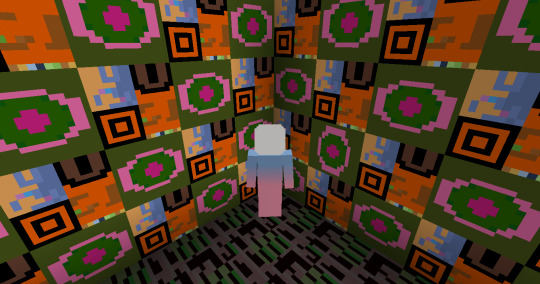
Abiogenesis is the name of my current Minecraft project. It's a resource pack and data pack based on a very old version of itself from 2017 that I recently began enthusiastic work on again.
When you abandon a world for long enough, it will teach itself things.
I haven't been super forthcoming with it all because I'd like to keep as much of it a surprise as possible, but I've split it this way for those who are more interested in just exploring the creative possibilities and those who are more interested in the "weirder" stuff.
(Almost) all of the tiles are created from corrupted graphics harvested from ROMs using the Realtime Corrupter. I use Resource Pack Workbench, an old and (to my understanding) retired program to manage my files.
...

..Was that door always here...?
113 notes
·
View notes
Note
I noticed that video creators I follow will sometimes release a video under one title and then change it to a different title a few days later. Why is that?
On YouTube 99% of how well a video does comes down to title and thumbnail, so it's good to try and optimise it using the realtime clickthrough data they give us
316 notes
·
View notes
Text
Real-time Market Data for Successful Trading in Indi
Real-time market data refers to live, continuously updated information about stock prices, trading volumes, bid-ask spreads, and other market activities. This data is available instantly as market transactions happen, helping investors and traders stay updated on price changes, market movements, and trading opportunities.

Real-time market data in India is provided by stock exchanges like NSE (National Stock Exchange) and BSE (Bombay Stock Exchange). It is also available on platforms like TrueData, Zerodha, Angel One, etc. where investors and traders can track stock prices and execute trades instantly.
Read Full Blog Post: Elevate Your Trading Strategy: The Role of Reliable Market Data in Achieving Success
#Authorised Data Vendor of real-time data#Realtime data for trading india#real-time stock market data api india
0 notes
Text






Asking @quiddie if she'd talk shop w/ me about the storytelling of WBN, part 2: the data!
Stats Beyond Number
When I get intrigued by a story, I like to deep dive, but it's never my first choice, because that process is only exciting for my writer brain. After writing 1M+ words of fiction, the urge to analyze every narrative choice is a hard thing to turn off -- but the first three episodes of Worlds Beyond were doing exactly that. My reader brain was delighted to be carried off to a new world by storytellers who I knew and trusted, and the early going was captivating, enchanting, exciting, etc.
Then at the 45m mark of episode 4, Suvi says to Ame:
"If this is what you need to do, then fine. But please, I ask you as a friend, do not presume to know how I feel, and NEVER contradict me in front of strangers."
Without my writer brain engaged, I reacted as I might in a real-life social encounter: instant red card, I'm never interacting with this person again.
But I wasn't going to let a little bump disturb me, especially with a project that was perfectly tailored to my interests. Longform, earnest fantasy storytelling with pro sound design and such a dream cast it might as well be made by Sega? I pressed on.
Episode 6, Suvi to Ame:
"Hey, shut up? Shut the fuck up."
Now I was starting to rationalize: it's early days, the Simpsons didn't even look like the Simpsons until like, season 3? I'll hang in.
Episode 11 -- the one where Suvi spins out in the shrine of Orima -- was so viscerally unpleasant I yanked my earbuds out in the grocery store and forgot about the podcast for a month.
During that time, the writer brain started to whir in the background.
I couldn't remember the last movie affected me like that. And there was something exciting about what Aabria was doing, on a technical level: it felt like she was jeopardizing the story's viability by going after a core tenet of most actual plays: good vibes only between PCs. Could the story work if the party doesn't get along? If, every week, the audience was at risk of TPK via psychic damage? Forget dangling your protagonists over shark-infested waters, that's real suspense!
So I got back into the story, this time with my analytic brain switched on. It was enjoyable! Watching four people writing in realtime is engrossing. While I struggle to appreciate emotional PVP in an unscripted context, it wasn't hard to appreciate the scene work between Aabria and Erika, and soon I was back on board -- Suvi actually became my favorite PC. For a goof, I ran some analysis on the transcripts, to see if I could find any fun patterns, but no real shockers in there. (It was a little wild to see that Steel was talking more than Eursulon, though.)
I got bored w/ the annotating after the second arc though, because of course the real thing a writer should study is: how's the audience responding? And there's a much more direct way to figure that out.
Part 3 on Friday: 10,000 reddit comments.
45 notes
·
View notes
Text
McMurdo Internet
Internet service is supplied to Antarctica via a geostationary satellite. This far south, the satellite is only a few degrees above the horizon, and unfortunately for McMurdo, it's behind Mt Erebus. So the signal is beamed to a receiver on Black Island, about 20 miles away to the southwest, and bounced over to the sheltered alcove at the end of the Hut Point Peninsula where McMurdo sits.
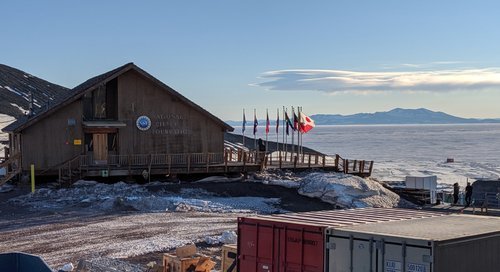
The Chalet, administrative hub, with Black Island in the distance
The Black Island telecommunications infrastructure was installed in the 1980s, long before the internet we know and love today. It was upgraded in 2010 to allow more data transfer, mainly realtime weather data to feed into global forecast models. For this reason, it's probably the only place I've ever been where upload speed is remarkably faster than download speed – 60Mbps for outbound traffic, but only 20Mbps for inbound. Most regular internet use is receiving, not sending, so that's an entire base running on a connection that's only marginally faster than the average American smartphone. As you can imagine, this is somewhat limiting.
The limits to one's internet access actually begin before one even reaches the Ice. At the orientation in Christchurch, one is directed to a URL from which one must download and install a security programme from the U.S. government. It may feel like a hippie commune full of nerds, but McMurdo is an installation of the American state, and as such its computer network is a target of whatever disgruntled conspiracy theorist decides to hack The Man on any given day. Computers that are allowed onto this network (such as the one on which I am typing right now) have to have an approved firewall and antivirus service installed, then this extra programme on top of them. I am not sure what it does. For all I know the CIA is spying on me even now. (Hi, guys!) But you need to install it to get on the McMurdo Internet, such as it is, so I did.
To be honest, I was rather looking forward to a month cut off entirely from the hyperconnected world, so I was a tiny bit disappointed that quite a lot of day-to-day communication is done by email, and I would need to be on my computer a fair bit to get it. Had I known just how important email would be, I'd have installed an email client that actually downloads one's messages instead of just fetching them; as it was, the cycle of loading an email and sending the reply, even in Gmail's "HTML for slow connections" mode, took about five minutes, not counting the time it took to write. Tending one's email was a serious time commitment; sometimes I felt like I was spending more time on the computer in Antarctica than I did at home.

Crary scientists waiting, and waiting, and waiting
In a way, though, I was lucky, because I was technically a scientist and therefore had access to the one building on base with WiFi, the Crary Lab. And don't think you can just waltz into Crary with your laptop and poach the WiFi – in order to access it at all, you have to get set up by Crary IT with your own personal WiFi login. If you do not have Crary access, your portal to the Internet is one of a handful of ethernet cables in each of the dorm common rooms, or some public terminals in the main building. You can hop on, download your emails, maybe check the news or Google something you needed to look up, and then leave it for someone else. When most online time sinks are either blocked or too heavy to load, it’s amazing how little internet time you actually turn out to need.
Things that we have come to take for granted in The World are not a part of McMurdo life. Social media is pretty much out – the main platforms are bandwidth hogs even before you try to load a video or an animated GIF. There is no sharing of YouTube links, and no Netflix and chill. Someone was once sent home mid-season for trying to download a movie. Video calls with family and friends? Forget it. People do occasionally do video calls from Antarctica, often to media outlets or schools, but these have to be booked in advance so as to have the requisite bandwidth reserved. Jumping on FaceTime does not happen – not least because handheld devices have to be in airplane mode at all times for security reasons. Your phone might be secure enough for your internet banking, but not for US government internet!
It is, unavoidably, still a digital environment, it just gets by largely without internet access. Nearly everyone has an external hard drive, mostly for media that they've brought down to fill their off hours. If you want to share files you just swap hard drives, or hand over a memory stick. When the Antarctic Heritage Trust wanted some book material from me, I dropped it onto an SD card and ran it over to Scott Base on foot – a droll juxtaposition of high- and low-tech, not to mention a good excuse for a hike over The Gap on a beautiful day. It took half an hour, but was still faster than emailing it.
There is also a McMurdo Intranet, which includes a server for file sharing. Emailing someone your photos will take ages, but popping them into a folder on the I: drive and sending them a note to say you've done so (or, better yet, phoning them, or poking your head into their office) is much more efficient. To conserve space, this informal server partition is wiped every week, so you have to be quick about it, but it's an effective workaround, and also a good way to get relatively heavy resources to a large number of people in one go.
The telecommunications centre on Black Island is mostly automated, but like anything – perhaps more than some things, given the conditions – it needs to be maintained. There is a small hut out there for an equally small team of electricians and IT engineers; Black Island duty attracts the sort of person who might have been a lighthouse keeper back in the day.
Towards the end of my time on the Ice there was a spell where they needed to shut off the connection overnight, to do some necessary work. Given that most people's workdays extended at least to the shutoff time at 5:30 p.m., this meant essentially no internet for a large portion of the population, and some amusing flyers were posted up to notify everyone of the impending hardship.
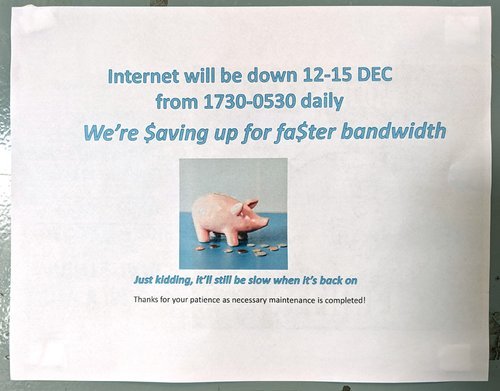
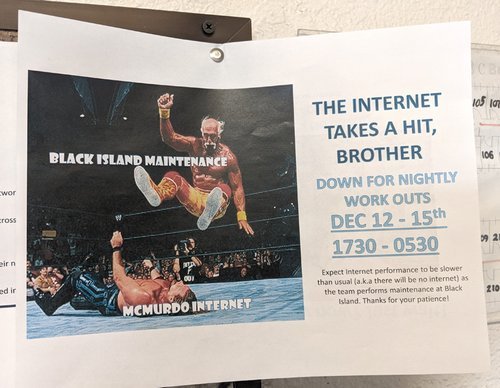
Someday, faster, more accessible internet will come to Antarctica. It's more or less unavoidable, as communications technology improves, and everyone's work – especially the scientists' – depends more and more on having a broadband connection at all times. It will make a lot of things more convenient, and will make the long separation from friends and family much easier. But I'm pretty sure that many more people will mourn the upgrade than celebrate it. One can, theoretically, curtail one's internet use whenever one likes, but even before the pandemic it was almost impossible to live this way with the demands of modern life: I know from personal experience that opting out of Facebook alone can have a real detrimental effect on relationships, even with people one sees in the flesh fairly regularly, simply because everyone assumes that is how everyone else communicates. Being in a community where no one has access to assumed channels, and is more or less cut off from the rest of the world in a pocket universe of its own, levels the playing field and brings a certain unity. The planned (and, unarguably, necessary) updating of the physical infrastructure of McMurdo will wipe out a lot of the improvised, make-do-and-mend character of the place; how much would free and easy access to the online world change it in a less tangible way?
I'm sure the genuine Antarctic old-timers would shake their heads at the phone and email connections we have now, and say that no, this has already ruined Antarctica. It's not Antarctica unless your only link to the outside world is a dodgy radio. It's not Antarctica unless you only get mail once a year when the relief ship arrives. Doubtless the shiny new McMurdo will be seen as 'the good old days' by someone, someday, too. Change may happen slower there than elsewhere, but just like the rust on the tins at Cape Evans, it comes eventually, regardless.
For my own part, I'm glad I got to see 'old' McMurdo, such as it was, all plywood and cheap '90s prefab. The update will be much more efficient, and tidy, but yet another generation removed from the raw experience of the old explorers. My generation is probably the last to remember clearly what life was like before ubiquitous broadband; to some extent, Antarctica is a sort of time capsule of that world, just as the huts are a time capsule of Edwardian frontier life. I hope they'll find a way to hang on to the positive aspects of that.
Now, if you'll excuse me, I'm off to waste an hour mindlessly refreshing Twitter ...
If you'd like to learn more about the Black Island facility, there's a lot of good information (and some photos!) here: https://www.southpolestation.com/trivia/90s/blackisland.html
And this Antarctic Sunarticle goes into greater depth on the 2010 upgrade: https://antarcticsun.usap.gov/features/2114/
409 notes
·
View notes
Text
There lay the days between
Artist: Katie Paterson (Scottish, b. 1981)
"Collaborating with scientists and researchers across the world, Paterson’s projects consider our place on Earth in the context of geological time and change." (https://katiepaterson.org/about/)
Artwork: There lay the days between, 2022
"A ticker board which displays the number of times the Sun has risen since the Earth was formed. The changing flap display switches by one digit each day, at sunrise." (https://katiepaterson.org/artwork/there-lay-the-days-between/)

Climate: The work has involved extensive scientific research and engagement tidal systems, moon systems and thermal evolution, for example, drawing upon data which is documenting how these systems are changing over time.
Time: Engages with the temporal cycle of the sun rising and setting as a marker of time.
#installation-art#realtime#data-visualisation#attunement#timekeeping#geological#deep-time#climate-change#rhythmic-pedagogies
0 notes